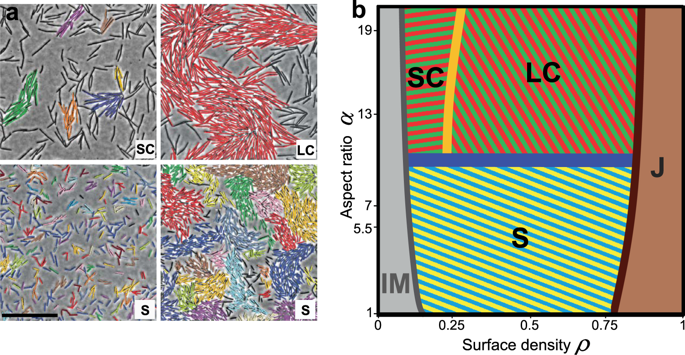Communications Physics ( IF 5.5 ) Pub Date : 2020-04-03 , DOI: 10.1038/s42005-020-0327-1 Avraham Be’er , Bella Ilkanaiv , Renan Gross , Daniel B. Kearns , Sebastian Heidenreich , Markus Bär , Gil Ariel

|
Bacterial swarming is a rapid mass-migration, in which thousands of cells spread collectively to colonize surfaces. Physically, swarming is a natural example for active particles that use energy to generate motion. Accordingly, understanding the constraints physics imposes on these dynamics is essential for understanding the mechanisms underlying swarming. We present new experiments of swarming Bacillus subtilis mutants with different aspect ratios and at different densities; two physical quantities known to be associated with collective behavior. Analyzing the dynamics reveals a rich phase diagram of qualitatively distinct swarming regimes, describing how cell shape and population density govern the dynamical characteristics of the swarm. In particular, we show that under standard conditions, bacteria inhabit a region of phase space that is associated with rapid mixing and robust dynamics, with homogeneous density and no preferred direction of motion. The results suggest that bacteria have adapted their physical properties to optimize the principle functions assumed for swarming.
中文翻译:

细菌蜂群的相图
细菌集群是一种快速的大规模迁移,其中成千上万个细胞共同扩散到殖民地的表面。从物理上讲,蜂群是使用能量产生运动的活性粒子的自然例子。因此,了解物理对这些动力学施加的约束对于理解群聚的机制至关重要。我们提出了新的丛生枯草芽孢杆菌的实验具有不同纵横比和不同密度的突变体;已知与集体行为有关的两个物理量。对动力学的分析揭示了定性上独特的群体机制的丰富相图,描述了细胞形状和种群密度如何控制群体的动力学特征。尤其是,我们表明,在标准条件下,细菌居住在相空间区域,该区域与快速混合和强大的动力学相关,具有均匀的密度并且没有首选的运动方向。结果表明细菌已经适应了它们的物理特性,从而优化了为群聚假设的主要功能。



























 京公网安备 11010802027423号
京公网安备 11010802027423号